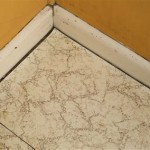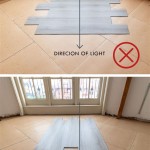Is Vinyl Wood Flooring Toxic? Evaluating the Health Risks
Vinyl wood flooring, a popular alternative to traditional hardwood, offers a blend of affordability, durability, and aesthetic appeal. However, concerns regarding potential health risks associated with its composition and manufacturing processes have surfaced. This article aims to examine the various aspects of vinyl wood flooring that contribute to these concerns and present a balanced assessment of its toxicity.
Vinyl flooring, including its wood-look variations, is primarily composed of polyvinyl chloride (PVC). PVC is a synthetic plastic polymer known for its versatility and resistance to moisture. The manufacturing process involves combining PVC resin with various additives, such as plasticizers, stabilizers, and pigments, to achieve the desired flexibility, durability, and color. These additives, depending on their chemical composition, are often the focal point of concerns regarding potential toxicity.
The potential for toxicity arises from the possible release of volatile organic compounds (VOCs) and the presence of certain chemicals that could leach from the flooring material over time. Exposure to these substances, even in low concentrations, has been linked to various health issues, particularly in sensitive individuals. Therefore, a thorough understanding of the components and potential emissions from vinyl wood flooring is crucial in evaluating its suitability for different environments.
VOC Emissions from Vinyl Wood Flooring
VOCs are organic chemicals that evaporate at room temperature, potentially polluting indoor air. Vinyl flooring, especially newly installed products, can emit a range of VOCs. The specific types and concentrations of VOCs released depend on the manufacturing process, the additives used, and the curing time of the adhesive, if any. Some common VOCs found in vinyl flooring include formaldehyde, benzene, toluene, ethylbenzene, and xylene (BTEX compounds).
Formaldehyde, a known human carcinogen, is used in some adhesives and resins. Exposure to formaldehyde can cause respiratory irritation, skin sensitization, and, in the long term, an increased risk of certain cancers. BTEX compounds, commonly found in petroleum-based products, can cause headaches, dizziness, nausea, and central nervous system effects. Prolonged exposure to high concentrations of BTEX compounds can have more severe consequences, affecting the liver, kidneys, and nervous system.
The good news is that many manufacturers are increasingly adopting low-VOC or VOC-free production methods. Look for certifications like FloorScore, Greenguard Gold, and others which indicate that the product has been tested and meets stringent VOC emission standards. These certifications provide assurance that the flooring material will contribute minimally to indoor air pollution. However, even low-VOC products can emit some level of VOCs, especially during the initial off-gassing period after installation. Adequate ventilation during and after installation is therefore recommended.
The Role of Phthalate Plasticizers
Phthalates are a group of chemicals widely used as plasticizers to make PVC flexible and pliable. They are not chemically bound to the PVC polymer and can leach out into the environment over time. Certain phthalates, such as di(2-ethylhexyl) phthalate (DEHP) and dibutyl phthalate (DBP), have been linked to adverse health effects, including endocrine disruption, developmental problems, and reproductive toxicity. These concerns have led to restrictions and bans on the use of certain phthalates in children's products and other applications in many countries.
While some phthalates have been phased out, others are still used in vinyl flooring production. Manufacturers are increasingly seeking alternatives to phthalates, such as non-phthalate plasticizers like DINCH (diisononyl cyclohexane-1,2-dicarboxylate). DINCH has been shown to have a lower toxicity profile than some traditional phthalates. However, it is crucial to examine the specific plasticizers used in the vinyl flooring you are considering and assess their potential risks.
The level of phthalate exposure from vinyl flooring depends on factors such as the concentration of phthalates in the product, the temperature, and the ventilation rate. Children, who spend more time on the floor and may put objects in their mouths, are considered to be at higher risk of exposure. Selecting phthalate-free vinyl flooring options significantly reduces the potential for exposure and associated health risks.
Heavy Metals and Stabilizers
Heavy metals, such as lead and cadmium, were previously used as stabilizers in vinyl flooring to enhance its durability and resistance to degradation. However, due to their known toxicity, their use has been significantly reduced or eliminated in many regions. Lead exposure, even at low levels, can cause neurological damage, developmental problems, and kidney damage, particularly in children. Cadmium is a known carcinogen and can also damage the kidneys and bones.
Modern vinyl flooring typically uses alternative stabilizers such as calcium-zinc or organic-based stabilizers. These newer stabilizers are considered to be less toxic than heavy metal-based alternatives. However, it is still important to verify that the vinyl flooring you choose is free from lead and cadmium. Reputable manufacturers will provide information on the absence of these heavy metals in their products. Look for certifications that specifically address heavy metal content.
The potential for exposure to heavy metals from vinyl flooring is relatively low, especially with newer products. However, older vinyl flooring, particularly those installed before stricter regulations were implemented, may contain higher levels of heavy metals. If you are renovating a home with older vinyl flooring, it is advisable to take precautions during removal to minimize dust generation and potential exposure. Consider consulting with a professional for proper removal and disposal of older flooring materials.
Furthermore, the manufacturing processes of PVC and its additives can generate other pollutants. Dioxins, highly toxic persistent environmental pollutants, can be produced during the production of chlorinated chemicals, including PVC. While modern manufacturing processes have significantly reduced dioxin emissions, it is still crucial to consider the overall environmental impact of PVC production. Selecting flooring options made from sustainable and eco-friendly materials can minimize the environmental burden associated with building materials.
The installation process of vinyl wood flooring also warrants consideration. Adhesives used to secure the flooring can emit VOCs, similar to the flooring itself. Choosing low-VOC or VOC-free adhesives is an important step in minimizing indoor air pollution. Furthermore, proper ventilation during and after installation is crucial to allow VOCs to dissipate. It is also advisable to follow the manufacturer's instructions for installation and maintenance to ensure the longevity and safety of the flooring.
Maintaining vinyl wood flooring properly can also influence its emission profile. Frequent cleaning with harsh chemicals can accelerate the degradation of the flooring material and potentially increase the release of VOCs and other chemicals. Using mild, non-toxic cleaning solutions is recommended to minimize potential exposure. Regularly wiping up spills and preventing the accumulation of dirt and grime will also help maintain the integrity of the flooring and reduce the need for heavy-duty cleaning products.
In conclusion, while vinyl wood flooring presents certain potential health risks, these risks can be mitigated by making informed choices. Selecting low-VOC, phthalate-free, and heavy metal-free products is essential. Proper installation with low-VOC adhesives and adequate ventilation is also crucial. Regular maintenance with gentle cleaning solutions can further reduce potential exposure to harmful chemicals. By carefully considering these factors, it is possible to enjoy the benefits of vinyl wood flooring while minimizing potential health concerns.

Are Vinyl Floors Toxic Olde Tyme Floor

Is Vinyl Flooring Harmful To Health Singapore Laminate

The Dangers Of Luxury Vinyl Floors Lvt And How You Can Avoid Them Artisan Wood Llc

The Dangers Of Luxury Vinyl Floors Lvt And How You Can Avoid Them Artisan Wood Llc

Is Vinyl Floor Considered Toxic By Timber Flooring Specialists Installation

Are Vinyl Floors Toxic Olde Tyme Floor

6 Vinyl Flooring Myths Get The Facts From Our Experts

Is Wpc Vinyl Flooring Toxic 3c China Rigid Core Luxury Plank Pvc Sheeet Manufacturer

Is Hybrid Flooring Toxic The Guys

Toxic Flooring Can Be A Threat To Your Home Labor S Blog
Related Posts








